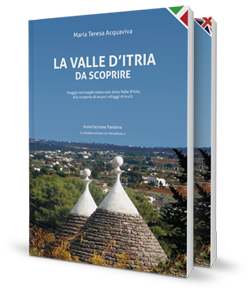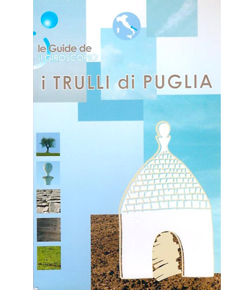Text translated by Emilio Acquaviva - Trainee
An sacred land, also known as Trulli Valley, with a landscape drawn from kilometres of dry stone walls which fence vineyards, vegetable gardens and orchards.
Halfway between Ionio and Adriatico seas, in the heart of Murgia of Trulli , is situated the enchanting Valle d’Itria , with a territory where hills and plains alternate. Three ancient towns, Martina Franca, Cisternino and Locorotondo, overlook on this place like natural balconies; while part of territories of Ostuni and Ceglie Messapica are parts of this valley.
The placename Itria has to be reported to the ancient worship of the Virgin Hodegetria, arrived here in the Middle Ages through basiliani monks who worshiped her image in a rocky church in the ground of a small sinkhole. On that site, in the sixteenth century, the convent structure of the Capuchin friars was built where, in the new church, the fresco of the Virgin Hodegitria was transported from the cave when this cult was already known in all the surroundingswith the name of Santa Maria d'Itria from which the whole valley took its name.
The placename Itria has to be reported to the ancient worship of the Virgin Hodegetria, arrived here in the Middle Ages through basiliani monks who worshiped her image in a rocky church in the ground of a small sinkhole. On that site, in the sixteenth century, the convent structure of the Capuchin friars was built where, in the new church, the fresco of the Virgin Hodegitria was transported from the cave when this cult was already known in all the surroundingswith the name of Santa Maria d'Itria from which the whole valley took its name.
The landscape of the Itria Valley is characterized by many kilometers of dry stone walls, which delimit the properties, and by thousands of casedde, the typical architectures that are an evolution of the archaic trullo used as a pastoral and agricultural refuge, widespread in the Murgia territory. The casedde were the houses of the farmers who lived in the Valley in sedentary form since the 19th century practicing the cultivation of the vine, Verdeca and Bianco d'Alessano were the cultivated vines. The thousands of casedde and the palmenti (where the grapes were pressed) transformed a landscape dominated by arable land and pastures into a landscape full of trulli and vineyards. Over the century, the winemaking technique has been improved by moving from family production to large-scale production of cellars that export the prestigious D.O.C. (controlled origin) and other types of vines.
The Valle d'Itria continues to be inhabited all year round but in a different way. The farmers have become agricultural entrepreneurs, the countryside has become a permanent residence for the local population and for many foreigners who fall in love with the landscape and who choose to live in the trulli. In addition, there are thousands of tourists who come to this place in every season to visit its historical and natural beauties. A calendar full of events improves the tourist offer with music, religious and gastronomic festivals, art exhibitions and historical re-enactments and with the numerous fairs of local products and crafts.













